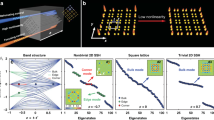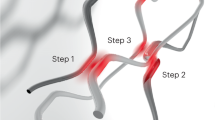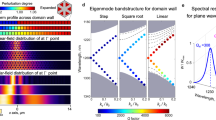Abstract
Manipulating topological invariants is possible by modifying the global properties of optical devices to alter their band structures. This could be achieved by statically altering devices or dynamically reconfiguring devices with considerably different geometric parameters, even though it inhibits switching speed. Recently, optical nonlinearity has emerged as a tool for tailoring topological and non-Hermitian (NH) properties, promising fast manipulation of topological phases. In this work, we observe topologically protected NH phase transitions driven by optical nonlinearity in a silicon nanophotonic Floquet topological insulator. The phase transition occurs from forbidden bandgaps to NH conducting edge modes, which emerge at a nonlinearity-induced gain–loss junction along the boundaries of a topological insulator. We find static NH edge modes and dynamic phase transitions involving exceptional points at a speed of hundreds of picoseconds, which inherently retain topological protections against fabrication imperfections. This work shows an interplay between topology and non-Hermiticity by means of nonlinear optics, and it provides a way of manipulating multiple phase transitions at high speeds that is applicable to many other materials with strong nonlinearities, which could promote the development of unconventionally robust light-controlled devices for classical and quantum applications.
This is a preview of subscription content, access via your institution
Access options
Access Nature and 54 other Nature Portfolio journals
Get Nature+, our best-value online-access subscription
$29.99 / 30 days
cancel any time
Subscribe to this journal
Receive 12 print issues and online access
$209.00 per year
only $17.42 per issue
Buy this article
- Purchase on Springer Link
- Instant access to full article PDF
Prices may be subject to local taxes which are calculated during checkout





Similar content being viewed by others
Data availability
The data that support the findings of this study are available from the corresponding authors upon reasonable request. Source data are provided with this paper.
References
Hasan, M. Z. & Kane, C. L. Colloquium: topological insulators. Rev. Mod. Phys. 82, 3045–3067 (2010).
Haldane, F. D. M. & Raghu, S. Possible realization of directional optical waveguides in photonic crystals with broken time-reversal symmetry. Phys. Rev. Lett. 100, 013904 (2008).
Wang, Z. et al. Observation of unidirectional backscattering-immune topological electromagnetic states. Nature 461, 772–775 (2009).
Lu, L., Joannopoulos, J. D. & Soljačić, M. Topological photonics. Nat. Photon. 8, 821–829 (2014).
Ozawa, T. et al. Topological photonics. Rev. Mod. Phys. 91, 015006 (2019).
Khanikaev, A. B. & Shvets, G. Two-dimensional topological photonics. Nat. Photon. 11, 763–773 (2017).
Rechtsman, M. C. et al. Photonic Floquet topological insulators. Nature 496, 196–200 (2013).
Maczewsky, L. J. et al. Observation of photonic anomalous Floquet topological insulators. Nat. Commun. 8, 13756 (2017).
Hafezi, M. et al. Robust optical delay lines with topological protection. Nat. Phys. 7, 907–912 (2011).
Hafezi, M. et al. Imaging topological edge states in silicon photonics. Nat. Photon. 7, 1001–1005 (2013).
Dong, J.-W. et al. Valley photonic crystals for control of spin and topology. Nat. Mater. 16, 298–302 (2017).
Shalaev, M. I. et al. Robust topologically protected transport in photonic crystals at telecommunication wavelengths. Nat. Nanotechnol. 14, 31–34 (2019).
Bender, C. M. & Boettcher, S. Real spectra in non-Hermitian Hamiltonians having pt symmetry. Phys. Rev. Lett. 80, 5243 (1998).
El-Ganainy, R. et al. Non-Hermitian physics and pt symmetry. Nat. Phys. 14, 11–19 (2018).
Feng, L., El-Ganainy, R. & Ge, L. Non-Hermitian photonics based on parity–time symmetry. Nat. Photon. 11, 752–762 (2017).
Özdemir, Ş. K. et al. Parity–time symmetry and exceptional points in photonics. Nat. Mater. 18, 783–798 (2019).
Weidemann, S. et al. Topological triple phase transition in non-Hermitian Floquet quasicrystals. Nature 601, 354–359 (2022).
Zhao, H. et al. Non-Hermitian topological light steering. Science 365, 1163–1166 (2019).
Ao, Y. et al. Topological phase transition in the non-Hermitian coupled resonator array. Phys. Rev. Lett. 125, 013902 (2020).
Bandres, M. A. et al. Topological insulator laser: experiments. Science 359, eaar4005 (2018).
Mittal, S., Goldschmidt, E. A. & Hafezi, M. A topological source of quantum light. Nature 561, 502–506 (2018).
Blanco-Redondo, A. et al. Topological protection of biphoton states. Science 362, 568–571 (2018).
Dai, T. et al. Topologically protected quantum entanglement emitters. Nat. Photon. 16, 248–257 (2022).
Weimann, S. et al. Topologically protected bound states in photonic parity–time-symmetric crystals. Nat. Mater 16, 433–438 (2017).
Xiao, L. Non-Hermitian bulk-boundary correspondence in quantum dynamics. Nat. Phys 16, 761–766 (2020).
Wang, K. et al. Generating arbitrary topological windings of a non-Hermitian band. Science 371, 1240–1245 (2021).
Boyd, R. W. Nonlinear Optics 2nd edn (Academic Press, 2008).
Smirnova, D. et al. Nonlinear topological photonics. Appl. Phys. Rev. 7, 021306 (2020).
Maczewsky, L. J. et al. Nonlinearity-induced photonic topological insulator. Science 370, 701–704 (2020).
Kruk, S. et al. Nonlinear light generation in topological nanostructures. Nat. Nanotechnol. 14, 126–130 (2019).
Hu, Z. et al. Nonlinear control of photonic higher-order topological bound states in the continuum. Light Sci. Appl. 10, 1–10 (2021).
Kirsch, M. S. et al. Nonlinear second-order photonic topological insulators. Nat. Phys. 17, 995–1000 (2021).
Mukherjee, S. & Rechtsman, M. C. Observation of Floquet solitons in a topological bandgap. Science 368, 856–859 (2020).
Konotop, V. V., Yang, J. & Zezyulin, D. A. Nonlinear waves in PT-symmetric systems. Rev. Mod. Phys. 88, 035002 (2016).
Rüter, C. E. et al. Observation of parity–time symmetry in optics. Nat. Phys. 6, 192–195 (2010).
Lumer, Y. et al. Nonlinearly induced PT transition in photonic systems. Phys. Rev. Lett. 111, 263901 (2013).
Xia, S. et al. Nonlinear tuning of PT symmetry and non-Hermitian topological states. Science 372, 72–76 (2021).
Minzioni, P. et al. Roadmap on all-optical processing. J. Opt. 21, 063001 (2019).
Wang, J. et al. Integrated photonic quantum technologies. Nat. Photon. 14, 273–284 (2020).
Zeljkovic, I. et al. Strain engineering Dirac surface states in heteroepitaxial topological crystalline insulator thin films. Nat. Nanotechnol. 10, 849–853 (2015).
Kudyshev, Z. A. et al. Photonic topological phase transition on demand. Nanophotonics 8, 1349–1356 (2019).
Cheng, X. et al. Robust reconfigurable electromagnetic pathways within a photonic topological insulator. Nat. Mater. 15, 542–548 (2016).
Leykam, D. et al. Reconfigurable topological phases in next-nearest-neighbor coupled resonator lattices. Phys. Rev. Lett. 121, 023901 (2018).
Shalaev, M. I., Walasik, W. & Litchinitser, N. M. Optically tunable topological photonic crystal. Optica 6, 839–844 (2019).
You, J. W. et al. Reprogrammable plasmonic topological insulators with ultrafast control. Nat. Commun. 12, 5468 (2021).
Rudner, M. S. et al. Anomalous edge states and the bulk-edge correspondence for periodically driven two-dimensional systems. Phys. Rev. X 3, 031005 (2013).
Kitagawa, T. et al. Topological characterization of periodically driven quantum systems. Phys. Rev. B 82, 235114 (2010).
Liang, G. Q. & Chong, Y. D. Optical resonator analog of a two-dimensional topological insulator. Phys. Rev. Lett. 110, 203904 (2013).
Afzal, S. et al. Realization of anomalous floquet insulators in strongly coupled nanophotonic lattices. Phys. Rev. Lett. 124, 253601 (2020).
Guglielmon, J. et al. Photonic realization of a transition to a strongly driven Floquet topological phase. Phys. Rev. A 97, 031801 (2018).
Foster, M. A. et al. Broad-band optical parametric gain on a silicon photonic chip. Nature 441, 960–963 (2006).
Lipson, M. The revolution of silicon photonics. Nat. Mat. 21, 974–975 (2022).
Acknowledgements
We acknowledge support from the National Natural Science Foundation of China (grant nos. 12325410, 61975001, 61590933, 11734001, 91950204, 92150302, 11527901,61904196, 62274179 and 62235001), the Innovation Program for Quantum Science and Technology (grant no. 2021ZD0301500), the National Key R&D Program of China (grant nos. 2019YFA0308702, 2018YFA0704404 and 2022YFB2802400), Beijing Natural Science Foundation (grant nos. Z190005 and Z220008), the Guangdong Major Project of Basic and Applied Basic Research (grant no. 2020B0301030009) and the Key R&D Program of Guangdong Province (grant no. 2018B030329001).
Author information
Authors and Affiliations
Contributions
T.D. and J.W. conceived the project. T.D., J.M., Y.Y., Y.Z., C.Z. and B.T. implemented the experiment. T.D. provided the simulations and performed the theoretical analysis. T.D., Y.A., Y.L. and J.Y. discussed and improved the theoretical results. Z.L., J.L., W.W., X.H., Q.G. and J.W. managed the project. T.D. and J.W. wrote the manuscript with input from all the authors. All the authors discussed the results and contributed to the manuscript.
Corresponding author
Ethics declarations
Competing interests
The authors declare no competing interests.
Peer review
Peer review information
Nature Physics thanks Jiangbin Gong and the other anonymous reviewer(s) for their contribution to the peer review of this work.
Additional information
Publisher’s note Springer Nature remains neutral with regard to jurisdictional claims in published maps and institutional affiliations.
Supplementary information
Supplementary Information
Supplementary Figs. 1–12 and Discussion.
Source data
Source Data Fig. 2
Statistical source data.
Source Data Fig. 3
Statistical source data.
Source Data Fig. 5
Statistical source data.
Rights and permissions
Springer Nature or its licensor (e.g. a society or other partner) holds exclusive rights to this article under a publishing agreement with the author(s) or other rightsholder(s); author self-archiving of the accepted manuscript version of this article is solely governed by the terms of such publishing agreement and applicable law.
About this article
Cite this article
Dai, T., Ao, Y., Mao, J. et al. Non-Hermitian topological phase transitions controlled by nonlinearity. Nat. Phys. 20, 101–108 (2024). https://doi.org/10.1038/s41567-023-02244-8
Received:
Accepted:
Published:
Issue Date:
DOI: https://doi.org/10.1038/s41567-023-02244-8
This article is cited by
-
Topological phase transitions have never been faster
Nature Physics (2024)



